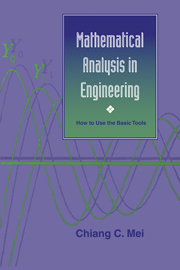Book contents
- Frontmatter
- Contents
- Preface
- Acknowledgments
- 1 Formulation of physical problems
- 2 Classification of equations with two independent variables
- 3 One-dimensional waves
- 4 Finite domains and separation of variables
- 5 Elements of Fourier series
- 6 Introduction to Green's functions
- 7 Unbounded domains and Fourier transforms
- 8 Bessel functions and circular boundaries
- 9 Complex variables
- 10 Laplace transform and initial value problems
- 11 Conformal mapping and hydrodynamics
- 12 Riemann–Hilbert problems in hydrodynamics and elasticity
- 13 Perturbation methods – the art of approximation
- 14 Computer algebra for perturbation analysis
- Appendices
- Bibliography
- Index
1 - Formulation of physical problems
Published online by Cambridge University Press: 05 June 2012
- Frontmatter
- Contents
- Preface
- Acknowledgments
- 1 Formulation of physical problems
- 2 Classification of equations with two independent variables
- 3 One-dimensional waves
- 4 Finite domains and separation of variables
- 5 Elements of Fourier series
- 6 Introduction to Green's functions
- 7 Unbounded domains and Fourier transforms
- 8 Bessel functions and circular boundaries
- 9 Complex variables
- 10 Laplace transform and initial value problems
- 11 Conformal mapping and hydrodynamics
- 12 Riemann–Hilbert problems in hydrodynamics and elasticity
- 13 Perturbation methods – the art of approximation
- 14 Computer algebra for perturbation analysis
- Appendices
- Bibliography
- Index
Summary
For an engineer or a physical scientist, the first necessary skill in doing theoretical analysis is to describe a problem in mathematical terms. To begin with, one must make use of the basic laws that elements of the problem. In continuum mechanics, these are the conservation laws for mass, momentum (Newton's second law), energy, etc. In addition, empirical constitutive laws are often needed to relate certain unknown variables; examples are Hooke's law between stress and strain, Fourier's law between heat flux and temperature, and Darcy's law between seepage velocity and pore pressure.
To derive the conservation law one may consider an infinitesimal element (a line segment, area, or volume element), yielding a differential equation directly. Alternatively, one may consider a control volume (or area, or line segment) of arbitrary size in the medium of interest. The law is first obtained in integral form; a differential equation is then derived by using the arbitrariness of the control volume. The two approaches are completely equivalent.
Let us first demonstrate the differential approach.
Transverse vibration of a taut string
Referring to Figure 1.1, we consider a taut string stretched between two fixed points at x = 0 and x = L and displaced laterally by a distribution of external force. Conservation of transverse momentum requires that the total lateral force on the string element be balanced by its inertia.
- Type
- Chapter
- Information
- Mathematical Analysis in EngineeringHow to Use the Basic Tools, pp. 1 - 19Publisher: Cambridge University PressPrint publication year: 1995



